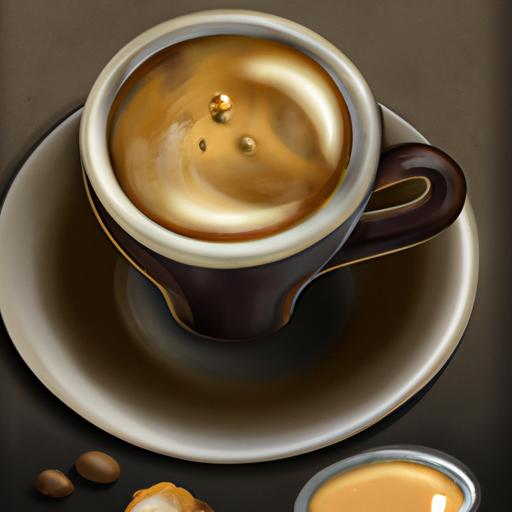Where did espresso originate? The answer is one that has been debated for centuries, with both the French and the Italians claiming to be the rightful inventors.
In this article, well uncover the truth behind this popular caffeinated beverage and explore the history of espresso, from its origin all the way to the many different types of espresso drinks.
Well also look at the differences between Italian and French espresso, and explore the many benefits that come with drinking espresso.
So, lets dive in and find out the answer to the question: Is espresso Italian or French?.
Table of Contents
Short Answer
Espresso is an Italian invention that originated in Italy in the early 1900s.
It is widely considered to be the most popular coffee beverage in Italy, and is a staple of Italian culture.
However, it has gained popularity in other countries, such as France, where it is widely consumed as well.
In France, espresso is often served with steamed milk, known as a caf au lait.
Origin of Espresso
When it comes to the origin of espresso, there is much debate as to where it originated.
While many believe that espresso was invented in Italy, others argue that the French also had a hand in its development.
The Italian espresso culture is well-known for its strong, full-bodied coffee, and espresso is the foundation of many Italian coffee drinks.
It is believed that the first espresso machine was made in Milan, Italy in 1884.
This machine was invented by Angelo Moriondo, and it created the first true espresso.
On the other hand, some believe that French inventor Louis-Napoleon Marton developed a method of making espresso in 1884 as well.
Marton’s machine was designed for the French market and was used to make cappuccino and caf au lait.
It is possible that the French had some influence on the development of espresso.
It is unclear which nation was first to develop espresso, as both Italy and France have claims to its origin.
What is certain, however, is that espresso has become a beloved part of both Italian and French culture.
Whether youre enjoying a cappuccino in Rome or a caf au lait in Paris, there is no doubt that espresso is a vital part of the culture in both countries.
Italian Espresso Culture

The Italian espresso culture is renowned for its strong, full-bodied flavor and is the foundation of many Italian coffee drinks.
The espresso is made using finely ground coffee beans that are subjected to nearly boiling water under pressure.
This method of brewing espresso results in a bold, concentrated cup of coffee with a layer of crema, or foam, on top.
The espresso is typically served in small demitasse cups, which are meant to be enjoyed in a single sip.
Italian espresso is known for more than just its flavor.
It is also a part of the Italian lifestyle, and is often enjoyed while socializing with friends or family.
Many Italian bars and cafes offer espresso, and it is a popular way to start the day.
Italians also enjoy espresso as a mid-morning pick-me-up and as a way to end a meal.
The Italian espresso culture has had a great influence on the rest of the world, and many countries have adopted it as their own.
From the United States to Japan, espresso has become a popular way to enjoy coffee.
Even though the origins of espresso are disputed, it is clear that it has been embraced by many cultures around the world, and it has become a part of the Italian way of life.
French Influence on Espresso
The debate over whether espresso is Italian or French is a contentious one.
While the Italians are credited with being the originators of espresso, there is some evidence to suggest that the French also played a role in its development.
In 1884, French inventor Louis-Napoleon Marton developed a method of making espresso.
He invented a steam-driven device that could quickly brew coffee, and it is believed that his invention was the first of its kind.
The device allowed for the rapid production of coffee, and it is likely that it contributed to the development of modern espresso machines.
The French influence on espresso does not stop there.
It is believed that the French were the first to introduce the concept of adding milk to espresso in order to create a latte or cappuccino.
The French are also credited with creating the iconic espresso cup, a small cup used to serve espresso.
It is clear that while the Italians are credited with creating espresso, the French have had a significant influence on its development.
From the invention of the steam-driven espresso machine to the introduction of milk-based espresso drinks, the French have made a lasting contribution to the espresso culture.
Espresso Brewing Technique

Espresso is a type of coffee that is brewed by forcing a small amount of nearly boiling water under pressure through finely ground coffee beans.
This method of brewing creates a full-bodied cup of coffee with a strong flavor and a thicker texture than regular drip coffee.
The technique was first developed in Italy in the early 1900s, but it is believed that French inventor Louis-Napoleon Marton developed a method of making espresso in 1884.
The espresso brewing technique requires a specialized machine to create the desired result.
The machine is typically made up of two parts: the group head and the boiler.
The group head is a metal tube that holds the coffee grounds, and the boiler is a chamber that holds the hot water.
When the machine is turned on, the hot water is forced through the coffee grounds, creating a concentrated espresso.
The key to making a great espresso is to control the temperature and pressure of the water.
The optimal temperature for brewing espresso is between 195 and 205 degrees Fahrenheit.
The optimal pressure for espresso brewing is 8 to 10 bars, which is about twice the pressure of a car tire.
The pressure and temperature must be carefully controlled in order for the espresso to have the desired flavor, texture, and strength.
The espresso brewing technique is used to create a variety of coffee drinks, such as cappuccinos, lattes, and macchiatos.
Espresso is also the foundation for many Italian coffee drinks, such as the classic espresso con panna and the popular affogato.
So while its origins may be disputed, it is widely believed that espresso originated in Italy and the Italian espresso culture is well-known for its strong, full-bodied coffee.
However, it is possible that the French have had some influence on the development of espresso, as Louis-Napoleon Marton is credited with developing a method of making espresso in 1884.
Different Types of Espresso Drinks
When it comes to espresso, there is no shortage of delicious drinks to explore.
From the classic Italian espresso shot to more complex drinks like cappuccino and latte macchiato, the range of espresso-based drinks is vast.
The espresso shot is the purest form of espresso and is a small, concentrated shot of coffee.
It has a thick, creamy consistency and packs a powerful caffeine punch.
This is the base for many other espresso drinks, including cappuccino and latte macchiato.
Cappuccino is a popular espresso drink made with espresso, steamed milk, and frothed milk.
It is often topped with a sprinkle of cocoa or cinnamon.
Latte macchiato is similar to cappuccino, but with more steamed milk and less frothed milk.
It is also typically topped with a sweetener like sugar or honey.
Finally, there is the caf mocha, a combination of espresso and hot chocolate.
This drink is often topped with whipped cream and cocoa powder.
All of these espresso drinks are delicious and have something to offer for every coffee lover.
No matter what type of espresso drink you choose, you can be sure that it has its roots in either Italian or French culture.
Whether you are sipping a classic espresso shot or indulging in a caf mocha, you can be sure that you are enjoying a beverage that has been perfected over the years.
Differences Between Italian and French Espresso

When it comes to the differences between Italian and French espresso, there are a few key factors to consider.
First, Italian espresso is usually brewed with a finer grind of coffee beans, resulting in a stronger and more concentrated flavor.
Additionally, Italian espresso is often served with a thicker crema on the surface, which adds a unique and delicious texture to the coffee.
French espresso, on the other hand, tends to be brewed with a coarser grind, resulting in a milder and more mellow flavor.
Furthermore, French espresso is often served without the crema, giving it a cleaner and crisper taste.
When it comes to preparation, Italian espresso is usually made with a traditional espresso machine, while French espresso is often made with a moka pot.
Finally, Italian espresso is typically served in small cups, while French espresso is usually served in larger cups.
Benefits of Espresso
Espresso is a wonderful way to enjoy a cup of coffee with its strong, full-bodied flavor and aroma.
This type of coffee is popular all around the world, and it is often used as the base for many different types of coffee drinks.
In addition to its great flavor, espresso also offers many other benefits that make it a great choice for coffee lovers.
One of the biggest benefits of espresso is its convenience.
Because it is brewed under pressure, espresso requires less time to prepare than other types of coffee.
This makes it ideal for those who are looking for a quick cup of coffee in the morning or for a mid-afternoon pick-me-up.
Additionally, espresso machines are relatively affordable, making them accessible for those who dont have a lot of money to invest in a coffee maker.
Another benefit of espresso is that it can be enjoyed in a variety of ways.
Whether you like your espresso with milk or without, it can be customized to fit your tastes.
Additionally, espresso can be used as the base for a variety of specialty coffee drinks, such as cappuccinos, lattes, and macchiatos.
This makes it a great choice for those who are looking to explore different coffee drinks and discover new flavors.
Finally, espresso offers a number of health benefits that make it a great choice for those looking to stay healthy.
Studies have shown that espresso can help reduce the risk of certain types of cancer, as well as heart disease.
Additionally, espresso contains caffeine, which can provide a boost of energy and alertness.
However, it is important to keep in mind that espresso should be enjoyed in moderation, as too much caffeine can have adverse effects on your health.
Overall, espresso is a great way to enjoy a cup of coffee.
With its strong flavor and convenience, it is no wonder that it has become a popular choice among coffee drinkers.
Additionally, espresso offers a number of health benefits that make it a great choice for those looking to stay healthy.
So, whether you believe it is Italian or French, espresso is a great choice for coffee lovers everywhere.
Final Thoughts
Espresso is an iconic coffee beverage with origins that are disputed between Italy and France.
While Italians are credited for perfecting the art of espresso-making, the French may have had an influence on its development.
The brewing technique and type of espresso drinks vary between the two countries, and each offers its own distinct flavor and benefits.
Understanding the differences between Italian and French espresso can help you make the best decision for your own personal taste.
So, the next time you visit a caf, why not try a cup of Italian or French espresso and find out which one you like best?.

